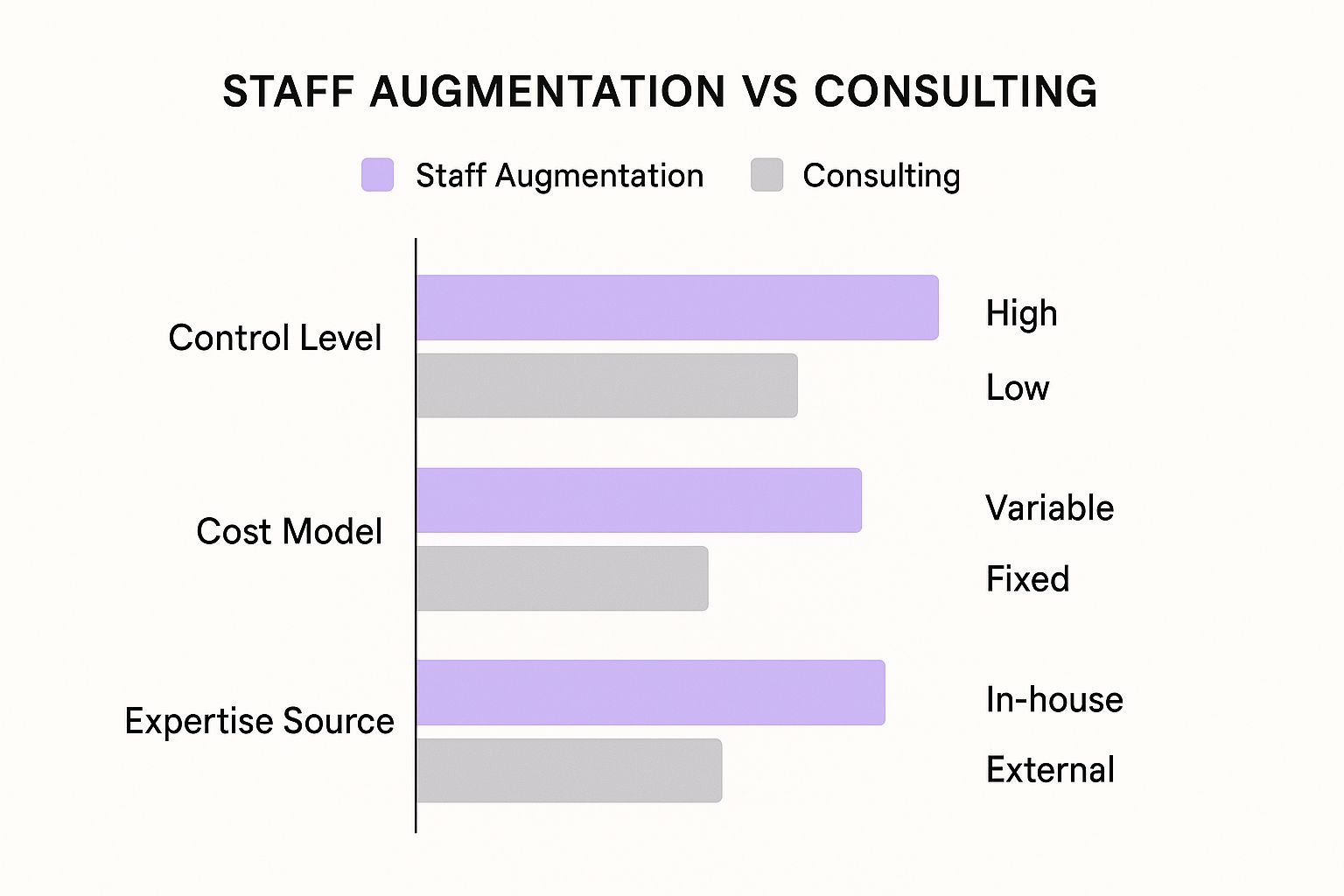
The real question in the staff augmentation vs consulting debate comes down to a single, critical choice: are you buying manpower or are you buying an outcome? Staff augmentation gives you skilled people to plug directly into your existing team, while consulting brings in an external firm to deliver a complete strategic solution.
You bring in augmented staff when you know what needs to be done but just don't have enough hands on deck. You hire consultants when you have a complex problem and need outside experts to own the strategy, execution, and final result.
Making the right call starts with being honest about your biggest need. Think of staff augmentation as hiring a specialist—a developer, a project manager, a designer—who joins your crew, takes direction from your managers, and helps you close a specific skill gap. They become, for all intents and purposes, a temporary part of your team.
Consulting, on the other hand, is like hiring an entire strategic unit. You're not just getting people; you're getting a fully managed service designed to dissect a challenge, build a solution, and see it through to completion. They work for you, but not within your team's daily structure.
This guide will go beyond the basic definitions. We’ll break down the crucial differences in control, cost, and expertise, using clear scenarios to help you confidently decide whether you need hands-on help or high-level strategic leadership.

This table lays out the fundamental differences between the two models, giving you a fast way to see where your needs fit.
| Attribute | Staff Augmentation | Consulting |
|---|---|---|
| Primary Goal | Fill a skill or capacity gap. | Solve a business problem or deliver a project. |
| Control Level | High: You manage the individual's daily tasks. | Low: The firm manages its team to deliver an outcome. |
| Integration | Fully integrated into your existing team. | Works externally as a separate, third-party entity. |
| Cost Model | Typically hourly or monthly rates per person. | Usually fixed-price or value-based project fees. |
| Best For | Adding specific technical skills or scaling your team. | Gaining strategic direction and specialized expertise. |
The fundamental choice is between buying time and skills (staff augmentation) versus buying a guaranteed outcome (consulting). Understanding this distinction is the first step toward making a financially sound and operationally effective decision for your business.
As you weigh these talent strategies, it's also worth looking into related models like outsourcing. For example, exploring the strategic advantages of contact center outsourcing can offer a fresh perspective. This approach often blends elements from both augmentation and consulting, making it a powerful option for scaling specific business functions with built-in expert oversight.
To really get to the bottom of the staff augmentation vs. consulting debate, you have to look past the high-level definitions. What matters is how each model plays out in the real world. The day-to-day experience, management structure, and team dynamics couldn't be more different, and those differences will directly shape your project's workflow and final outcome.

With staff augmentation, you’re essentially embedding an external professional directly into your team. They’re expected to adopt your company culture, jump into your project management tools, and report right up to your managers. It’s all about giving you complete operational control.
Think of it as a super-flexible hiring model. You get to add specific skills or just more horsepower to your team without the long-term commitments and overhead that come with a full-time hire.
Picture this: your project manager assigns tasks to the augmented team member just like they would to any other employee. This new person joins your daily stand-ups, participates in team meetings, and gets involved in your code reviews.
The whole game here is integration. Success hinges on making this external talent feel like they genuinely belong. When you get it right, you gain immediate access to skilled professionals who are plugged directly into your workflow. This makes it a perfect fit when you already have a clear roadmap but just need more hands on deck to hit your deadlines.
Key Takeaway: Staff augmentation is about adding people to your existing structure. You keep total control over the "what" and the "how," making this model a direct extension of your current team.
Of course, when you bring on temporary talent like freelancers, you need to have your operational ducks in a row. Nailing down processes like efficient invoice management for freelancers is crucial for keeping the financial side smooth and avoiding administrative headaches.
A consulting partnership, on the other hand, operates from the outside. The consulting firm doesn’t just give you people; they bring their own proven methodologies, project managers, and strategic frameworks to the table. Their goal is to deliver a specific, predefined outcome. You tell them what you need, and they own the entire process of getting you there.
A typical consulting engagement kicks off with a deep-dive discovery phase. The consultants dig into your problem and come back with a proposed solution. From there, their team works mostly independently, providing you with regular progress updates while managing their own day-to-day tasks and resources. Their accountability is for delivering the final project, not just logging hours.
This approach is less about adding hands to your team and more about outsourcing the entire problem—and its solution—to a specialized third party who can provide strategic direction and guarantee results.
Choosing between staff augmentation and consulting isn't just a simple pros and cons list. It's about getting real about what your project needs most. The right choice always comes down to three things: how much control you need to keep, what kind of cost structure your budget can handle, and whether you need tactical skills or high-level strategic expertise. Get clear on these, and the best path forward will reveal itself.
This visual breaks down the core differences in control, cost, and expertise between the two models.

As you can see, staff augmentation keeps control high and costs variable. Consulting, on the other hand, trades direct control for fixed costs and outside strategic guidance.
To help you decide, here’s a quick comparison of the key differentiators between staff augmentation and consulting. This table breaks down what you get with each model, making it easier to see which one fits your project's unique demands.
| Attribute | Staff Augmentation | Consulting |
|---|---|---|
| Control | High. You manage daily tasks and priorities. | Low. The firm manages their team and methodology. |
| Cost Structure | Variable. Typically hourly or monthly rates per person. | Fixed. Project-based fee for the entire engagement. |
| Management | Internal. Your managers direct the augmented staff. | External. The consulting firm manages its own resources. |
| Expertise | Tactical. Fills specific skill gaps (e.g., a Python developer). | Strategic. Provides high-level roadmaps and solutions. |
| Integration | Direct. Talent integrates into your existing teams. | Indirect. Works as a separate, outcome-focused unit. |
| Goal | Execution. Adds manpower to complete defined tasks. | Strategy. Solves complex problems or defines direction. |
This table gives you a high-level view, but the real decision lies in the details of your situation. Let's explore what these differences mean in practice.
Your need for direct oversight is one of the biggest forks in the road when comparing staff augmentation vs. consulting. Staff augmentation puts you firmly in the driver's seat. You manage the new team members' day-to-day tasks, set their priorities, and plug them right into your project management tools. This level of control is perfect when you already have a solid plan and just need more hands on deck to get it done.
Consulting flips that script. When you hire a consulting firm, you're handing over the reins for the "how." They bring their own team, their own methods, and are held accountable for delivering a specific outcome. Your role becomes more strategic—signing off on milestones and providing high-level feedback, not micromanaging daily work.
The trade-off is straightforward: staff augmentation gives you direct control over people, while consulting gives you control over outcomes. You have to decide which is more critical for your project's success.
The way you pay for these services couldn't be more different. Staff augmentation almost always works on a transparent, time-based model, like an hourly or monthly rate for each person you bring on. This makes it easy to budget for adding specific roles and to scale your team up or down as needed. You're paying for time and skills, which covers the provider's overhead but saves you the hefty costs of benefits and payroll taxes that come with a full-time hire.
Consulting, by contrast, is usually priced based on the project's value or a fixed fee for the whole engagement. Yes, that number looks higher on paper, but it covers a lot more: the firm's strategic brainpower, their project management, and a guarantee of results. While the initial check is bigger, a great consulting engagement can deliver massive ROI by helping you sidestep expensive mistakes, get to market faster, or crack a tough business problem.
Finally, think hard about the kind of knowledge you're trying to bring in. Staff augmentation is all about acquiring specific, tactical skills. If your team is missing a mobile developer who knows React Native or a data analyst who's a wizard with Tableau, augmentation delivers that precise skill set. The expertise is deep but focused, designed to plug a well-defined hole in your roster.
Consulting brings in broad, strategic expertise. You hire consultants for their bird's-eye view of the industry, their battle-tested frameworks, and their ability to look at your challenges with fresh, objective eyes. They don't just fill a skills gap; they deliver a complete solution. This is priceless when you’re navigating a major digital transformation, launching in a new market, or just need a clear roadmap for a highly complex project.
Thinking about these talent models often brings up similar questions as when deciding between contractors and permanent staff. For more on that, our guide on hiring freelancers in LATAM vs full-time employees offers some valuable parallels that can help clarify your decision.
When you're weighing staff augmentation vs. consulting, it's easy to get fixated on the price tag. But looking at an hourly rate for an augmented professional versus a project fee for a consulting firm is like comparing apples and oranges—it only tells you a sliver of the story. The real financial picture emerges when you look at the total cost of ownership and the long-term return on investment (ROI) each model brings to the table.

Staff augmentation gives you immediate, transparent clarity on your budget. You pay a simple rate for the talent you need, sidestepping all the heavy overhead that comes with full-time hires—think benefits, payroll taxes, and new equipment. This makes it an incredibly efficient way to boost your team's output without bloating your fixed costs.
On the other hand, consulting engagements almost always come with a higher upfront cost. But it's best to see this as a strategic investment designed to generate major returns down the line. A consultant’s expert guidance can help you dodge costly mistakes, slash your time-to-market, or roll out solutions that create new revenue streams and make your operations leaner.
Imagine a consultant spots a fundamental flaw in your development process that would have cost your company months of wasted work. Suddenly, their fee looks like a bargain compared to the disaster you just avoided. The value isn't measured in hours worked; it's measured in the strategic outcome they deliver.
The core financial question is this: Are you trying to manage a predictable operational expense or are you investing capital to achieve a major strategic goal? Your answer will point you toward the right model.
Of course, cost-effectiveness is always a factor. Staff augmentation usually wins on this front because the provider handles all the auxiliary employee expenses, leaving you to pay only for the professional's time. Consulting is pricier because you're also paying for strategic leadership and project management, but that investment can lower your overall project risk by reducing the need for intensive oversight from your team.
So, while augmentation often has an edge in pure cost savings, consulting is the go-to when you need expert guidance to navigate complex business changes.
For a clearer financial picture, it helps to look at related costs in the talent market. Resources on topics like virtual assistant rates offer solid cost benchmarks for different types of external talent. Similarly, digging into the cost-benefit ratio of hiring from LATAM vs local talent can sharpen your financial strategy, especially if you're considering global talent pools.
Figuring out whether to go with staff augmentation or consulting really boils down to one simple question: do you already have a plan, or do you need someone to help you build one? It's the classic "tactical execution versus strategic guidance" dilemma. Get this choice right, and you're on the fast track. Get it wrong, and you could waste a lot of time and money.
Market trends show that companies are using both models for very different reasons. Right now, about 60% of businesses use staff augmentation to add muscle to their teams on demand. They love the flexibility and the cost savings that come from not having to deal with payroll taxes or benefits. On the flip side, 72% of companies bring in consultants when they're staring down a complex problem and need expert advice to de-risk the situation.
With 92% of Global 2000 companies using some form of IT outsourcing, it's clear both models are essential tools. You can dive deeper into these trends in this analysis of talent models. The key is to match your specific need to the right solution.
Staff augmentation is your best bet when your roadmap is solid, but you’re short on either the specific skills or the sheer manpower to get it done. You're not looking for someone to tell you what to do; you need skilled professionals to help you do it faster.
Think of it as adding firepower to your existing crew.
Choose staff augmentation when you need to:
Key Insight: Staff augmentation works best when the "what" and "why" are already solved. You're simply bringing in talent to help with the "how" under your direct management.
Consulting is the answer when you're facing a messy, high-stakes problem with no obvious solution. You aren't just buying a pair of hands; you're investing in a strategic brain, an objective perspective, and a proven playbook for navigating complex challenges.
You bring in consultants when you need a new map, not just more people for the journey.
Choose consulting when you need to:
When applying these models across borders, understanding the local dynamics is key. For practical advice, check out our guide on how to build a remote team with Latin American talent.
Even after you've grasped the core differences between staff augmentation vs consulting, a few practical questions always seem to pop up. Business leaders want direct answers to these common sticking points before they commit to a talent strategy. This section is here to tackle those questions head-on and help you feel confident in your final decision.
This is a classic question, but the answer really hinges on what kind of flexibility you're after.
Staff augmentation is the hands-down winner for personnel flexibility. You can scale your team up or down with incredible speed. Need to add a few developers for a critical sprint? No problem. Project phase is over? You can release the contractors just as quickly. This on-demand access to talent is perfect for handling those unpredictable workloads and keeping your permanent team lean.
Consulting, on the other hand, gives you greater strategic flexibility. While the work is usually tied to a formal statement of work, consultants are masters of adapting to new information. If they unearth an unexpected roadblock or a massive opportunity during their discovery phase, they have the authority to pivot the entire project's scope to address it. That's a level of adaptability a task-focused augmented resource just can't offer.
The way skills and project insights get passed to your permanent team is vastly different between these two models, and it’s a critical factor for your company's long-term growth.
With staff augmentation, knowledge transfer is an organic, almost unconscious process. Your augmented pro works side-by-side with your employees, using your systems and joining your daily stand-ups. Skills get shared naturally through collaboration and osmosis. Your team learns by doing, picking up new techniques and best practices in the flow of work.
In a consulting engagement, knowledge transfer is much more formal and structured. It's a deliberate event that happens toward the end of the project. Think comprehensive documentation, dedicated training workshops, and official handover meetings. The entire goal is to package up the solution and equip your team to own and manage it long after the consultants are gone.
Key Consideration: If your primary goal is to organically upskill your team through daily collaboration, staff augmentation is the clear choice. If you need a complete, documented system handed over as a finished product, consulting is built for exactly that.
Absolutely. In fact, this hybrid approach isn't just common—it's often the most effective way to go. Many businesses realize that the path from a complex problem to a finished solution requires both big-picture guidance and hands-on execution, making a switch between models feel like a natural progression.
Here’s a common scenario: a company might kick off a consulting engagement to solve a huge strategic puzzle, like mapping out a company-wide digital transformation. The consultants will analyze the business, pinpoint opportunities, and deliver a detailed strategic plan.
But once that blueprint is in hand, the company's needs change. They no longer need high-level strategy; they need tactical execution. This is the perfect time to switch to a staff augmentation model. They can take the consultants' roadmap and hire a team of skilled developers, PMs, and QA testers to build and implement the solution, all under their direct management. This phased approach truly gives you the best of both worlds—expert strategy upfront and cost-effective execution on the back end.
Both models can work for long-term projects, but their suitability really depends on the nature of the project itself.
Consulting often shines in long-term strategic initiatives where the goals might evolve. For a multi-year business transformation, a consulting partner provides that continuous, high-level guidance, adjusting the strategy as the market shifts or your business priorities change.
Staff augmentation is a better fit for long-term execution-focused needs. If you have an ongoing requirement for specific skills to support your core products or daily operations, using augmented staff is often more cost-effective and flexible than hiring full-time employees, especially if you think the skills you need might change down the line.
